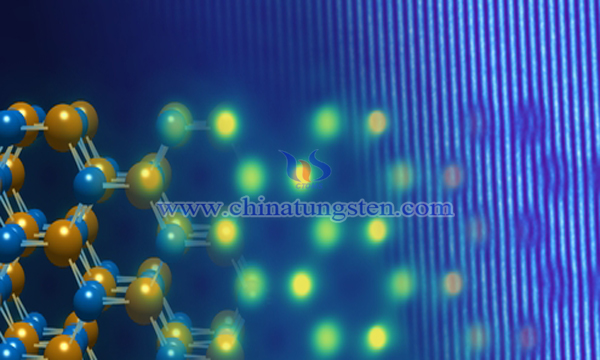Two-dimensional Tungsten Disilicide Semiconductor Material
- Details
- Category: Tungsten Information
- Published on Sunday, 13 October 2019 23:08
Nanomaterials refer to materials whose dimensions reach the nanometer scale in a certain dimension, two-dimensional or three-dimensional direction. It can be divided into zero-dimensional materials, one-dimensional materials, two-dimensional materials, three-dimensional materials. When a conventional material reaches the nanometer scale, its properties will be very different from usual. When the nanomaterial is a single atomic thickness, it is a two-dimensional material, representative of which is the first published graphene in 2004. In recent years, transition metal two-dimensional materials have also received great attention from scientists, such as tungsten disulfide, molybdenum disulfide or tungsten diselide, which have great potential for the next generation of electronic products.
Two-dimensional transition metal disulfide (TMD) is expected to be used in a variety of next-generation electronic and optoelectronic applications. However, in order to fully exploit the potential of these semiconductors, researchers need to be able to fabricate very thin wires from these materials in order to use them as atomic contacts. This nanowire requires a two-dimensional material that is smaller and thinner. One-dimensional material.

Two-dimensional materials refer to materials in which electrons can move freely on a non-nano scale in two dimensions, while one-dimensional materials remove one dimension. The main forms of such materials are nanowires, nanorods, nanotubes, etc. It must be pointed out that the preparation of graphene, tungsten disulfide (molybdenum) or any other two-dimensional, one-dimensional material, there is currently no economically viable production process.
Recently, a scientific team at Cornell University in New York has adopted a new "dislocation catalysis" technology to successfully embed a one-dimensional molybdenum sulfide channel in a two-dimensional tungsten selenide monolayer. In the end, the edge of the one-dimensional channel has no mismatch misalignment and dangling keys, so it can be easily extended to other 2D materials such as tungsten diselenide and molybdenum disulfide.For the details of the study, the scientists said: "Reducing the thickness of the 2D material of the atomic layer thickness is crucial for the future of such materials to break through the existing wafer-based wafer pattern. Because the future of 2D materials will reduces the size of existing wafers to a few nanometers, which is of great significance for semiconductor expansion of future wafers. It is conceivable that wafers that can be implanted into the human body, or smarter computer facilities or robots, will appear.
Previously, researchers have fabricated 2D heterostructure devices primarily by lithographically patterning a 2D layer of one material and then growing another layer of 2D material on top of the first layer in the patterned region. Although this technique can control the size of the material to around 100 nanometers, the lithographic patterning process itself produces atomic defects and contamination. The atomic junctions in these heterostructures contain electron-defective states that adversely affect the final electronic properties of the device.
Thus, the research team proposed a new method to create a consistent one-dimensional channel in a two-dimensional heterostructure. Firstly, they made a lateral interface between two two-dimensional transition metal dichalcogenide materials, molybdenum disulfide (MoS2) and tungsten disilicide (WSe2). The precursor molecules are then introduced into the bulk to provide a high chemical potential for the channel material, one-dimensional molybdenum disulfide nanowires (MoS2). The core of misfit dislocations is more reactive than its surroundings, which allows channel atoms (Mo and S) to be inserted into the dislocation core. This pushes the dislocations away from the original interface between MoS2 and WSe2, and the process creates a one-dimensional MoS2 channel in the trajectory behind the core.
These channels are less than 2 nm wide and have no dislocations and dangling bonds on the sidewalls. This technique, called "dislocation catalysis", was explained by the researchers: "This dislocation-catalyzed growth technique is like replacing a white silk with a red silk sheet. More vividly, because of the connection of semiconductor one-dimensional nanowires, the exchange channel between two-dimensional semiconductor materials has changed from a small intestine path to a high-speed railway. This process will play a vital role in semiconductor nanoscience."
Finally, scientists also believe that, based on their density functional calculations, one-dimensional molybdenum disulfide (MoS2) wires have extraordinary electronic properties that can be applied, such as quantum confinement and type II tape alignment, and they hope to use two-dimensional materials. They are patterned and these patterned 2D materials are stacked to create highly integrated flexible and transparent circuits that are useful for future development of new computer devices.
- Tungsten Manufacturer & Supplier, Chinatungsten Online: www.chinatungsten.com
- Tungsten News & Prices of China Tungsten Industry Association: www.ctia.com.cn
- Molybdenum News & Price: news.molybdenum.com.cn
- Tel.: 86 592 5129696; Fax: 86 592 5129797; Email: sales@chinatungsten.com



 sales@chinatungsten.com
sales@chinatungsten.com